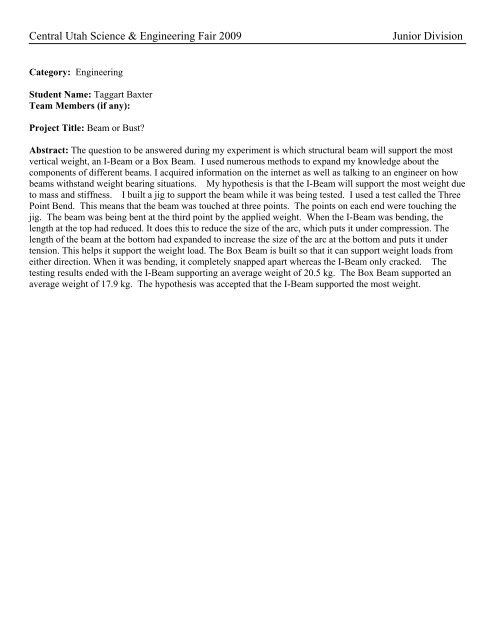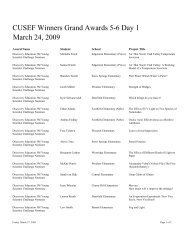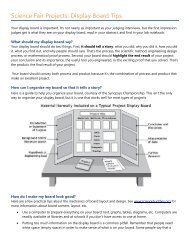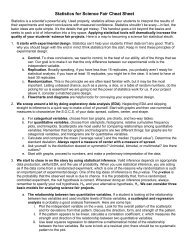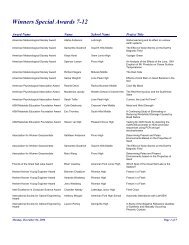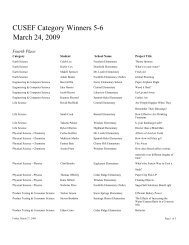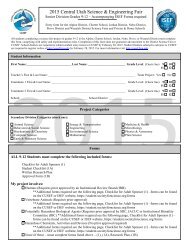Central Utah Science & Engineering Fair 2009 Junior Division
Central Utah Science & Engineering Fair 2009 Junior Division
Central Utah Science & Engineering Fair 2009 Junior Division
You also want an ePaper? Increase the reach of your titles
YUMPU automatically turns print PDFs into web optimized ePapers that Google loves.
<strong>Central</strong> <strong>Utah</strong> <strong>Science</strong> & <strong>Engineering</strong> <strong>Fair</strong> <strong>2009</strong><strong>Junior</strong> <strong>Division</strong>Category: <strong>Engineering</strong>Student Name: Taggart BaxterTeam Members (if any):Project Title: Beam or Bust?Abstract: The question to be answered during my experiment is which structural beam will support the mostvertical weight, an I-Beam or a Box Beam. I used numerous methods to expand my knowledge about thecomponents of different beams. I acquired information on the internet as well as talking to an engineer on howbeams withstand weight bearing situations. My hypothesis is that the I-Beam will support the most weight dueto mass and stiffness. I built a jig to support the beam while it was being tested. I used a test called the ThreePoint Bend. This means that the beam was touched at three points. The points on each end were touching thejig. The beam was being bent at the third point by the applied weight. When the I-Beam was bending, thelength at the top had reduced. It does this to reduce the size of the arc, which puts it under compression. Thelength of the beam at the bottom had expanded to increase the size of the arc at the bottom and puts it undertension. This helps it support the weight load. The Box Beam is built so that it can support weight loads fromeither direction. When it was bending, it completely snapped apart whereas the I-Beam only cracked. Thetesting results ended with the I-Beam supporting an average weight of 20.5 kg. The Box Beam supported anaverage weight of 17.9 kg. The hypothesis was accepted that the I-Beam supported the most weight.
<strong>Central</strong> <strong>Utah</strong> <strong>Science</strong> & <strong>Engineering</strong> <strong>Fair</strong> <strong>2009</strong><strong>Junior</strong> <strong>Division</strong>Category: <strong>Engineering</strong>Student Name: Mitch BrownTeam Members (if any):Project Title: The Strength of Wood in BridgesAbstract: My science fair project was to determine how different types of wood affect the bearing capacity(strength) of wood bridges. I would build model bridges out of different types of wood and test them todetermine their strength. I decide to use three types of wood for the bridges, balsa wood, Popsicle sticks, and1/8 wooden dowels. I thought that if I construct the bridges the same way, the Popsicle stick bridge will holdthe most weight. The popsicle stick wood is bigger and harder than all the other wood, so I think it will hold themost. I constructed three bridges using an I-beam design as the members in the bridge. I tested them todetermine the weight that they would hold using a concrete cylinder testing machine. The Popsicle Bridge held1,910 pounds and failed at a connection. The wooden dowel bridge held 1,760 pounds and failed in an I-beam.The balsa wood bridge held 3,100 pounds and had the I-beam fail. The Popsicle stick bridge was supposed tohold the most load. By the way things were looking during the testing, it would have held the most load, but ithad a failure in the connections between two beams. Because of this type of failure we were not able todetermine which material could hold the most weight. I found out that most bridge failures occur in theconnections.
<strong>Central</strong> <strong>Utah</strong> <strong>Science</strong> & <strong>Engineering</strong> <strong>Fair</strong> <strong>2009</strong><strong>Junior</strong> <strong>Division</strong>Category: <strong>Engineering</strong>Student Name: Cheyenne ConnellyTeam Members (if any):Project Title: Insulation In A BoxAbstract: My question is what home insulation does the best for it's quality and price? My hypothesis:I thinkthat the icynene foam insulation will be the best insulator because it looks like it will really stick to the wallsand insulate better. ~For the worst, the cellulose because I think that it will settle in the walls and only insulatethe bottom of the walls.~For the best price for the quality of the insulation,I would have to say the R13 battinsulation because it looks like it will be a reasonable price for the quality of the insulation.~For the mostexpensive price for the quality of the insulation, I think is the icynene foam, because it is like this spray thatafter you spray it, it puffs up and it would seal to the walls and leave no air holes for heat to escape. Method: Ibuilt 4 boxes out of 2x4 wood to simulate the standard wall cavity of a home, then used the 4 different types ofinsulation to do my expeiriment of what one would hold in the heat the best, for the best price. Results: TheIcyene foam held in the heat the best, but it is most expensive. The optima bibs held in the heat the second bestand it is alot better price. The R-13 batt was the third best and is cheaper than the worst insulation which is thecellulose. The cellulose insulation also settles in the walls overtime and allows heat to escape your home.
<strong>Central</strong> <strong>Utah</strong> <strong>Science</strong> & <strong>Engineering</strong> <strong>Fair</strong> <strong>2009</strong><strong>Junior</strong> <strong>Division</strong>Category: <strong>Engineering</strong>Student Name: Chris MarstonTeam Members (if any):Project Title: Got Wind?Abstract: My question was: What blade shape would spin the fastest on a wind turbine to create the greatestpotential enegy output in watts. My hypothesis was that a blade shape that has more surface area for wind toto push or lift and mive it will spin fasstest unders contant wind velocity. I had to learn what varibles wouldgive me incorrect results if not controlled-like constant wind, gear set up, blade materials of construction, etc.I assembled a wind turbine, made a test set of blades and workded to get consistant output. Everything seemedto go wrong, the fan was not powerful enough, the multimeter did not read out to enough decimals, so myresults could not be measured. I found a more powerful fan-but still not the best, and changed how I wouldmeasure by counting revolutions per minute. I made 5 blade sets out of the same material and the same lengthto control windswept area and measured rpm repeatedly for each set of blades. I also needed to change theangle for each shape to obtain optimum performance. So constant speed, 5 blades, test repeated 5 times atdifferent angles. All blade sets tested exactly the same. I searched for a conversion from rpm to watts. Noluck-even called engineers. Learned you can't make that direct comparison. Put my results on a table and<strong>Central</strong> <strong>Utah</strong> <strong>Science</strong> & <strong>Engineering</strong> <strong>Fair</strong> <strong>2009</strong><strong>Junior</strong> <strong>Division</strong>determined blade shape A spun the fastest-and it had the greatest surface area. Surface area was determinedvisually. This was a really fun experiment.
<strong>Central</strong> <strong>Utah</strong> <strong>Science</strong> & <strong>Engineering</strong> <strong>Fair</strong> <strong>2009</strong><strong>Junior</strong> <strong>Division</strong>Category: <strong>Engineering</strong>Student Name: Sasha McKeeTeam Members (if any):Project Title: Ready, Aim, FireAbstract: This paper determines the effect of air pressure on distance for a marshmallow launcher. Myhypothesis was that the 120 psi (pounds per square inch) will blow the marshmallow the farthest. Afterconstructing the marshmallow launcher, a pressure-regulated air-compressor was utilized to launchmarshmallows at increasing pressures. At each pressure, eight runs were performed and the data recorded. Thefarthest distance a marshmallow traveled was the control (mouth) at 339 inches, the control (mouth) was alsothe longest average distance at 262 inches, the shortest average distance was at 90 inches for 40 psi and thelongest average distance using the air compressor was at 80 psi.
<strong>Central</strong> <strong>Utah</strong> <strong>Science</strong> & <strong>Engineering</strong> <strong>Fair</strong> <strong>2009</strong><strong>Junior</strong> <strong>Division</strong>Category: <strong>Engineering</strong>Student Name: Ryo RuizTeam Members (if any):Project Title: DTV vs. ATVAbstract: Why I chose this project is because, when the science fair season comes I try to look for the coolestand best technology out there. So right when I saw this I knew it was the right one. So what I wanted to knowwas, is there really a noticeable difference between digital television and analog television. My method to solvethis was to compare and research to see which one had the noticeable difference. So what I got out of all this isdigital won by a landslide with the numbers, pixels for DTV: 1920x1080 and for ATV: 512x400, and theresolution for DTV:2,730,600 and for ATV:204,800
<strong>Central</strong> <strong>Utah</strong> <strong>Science</strong> & <strong>Engineering</strong> <strong>Fair</strong> <strong>2009</strong><strong>Junior</strong> <strong>Division</strong>Category: <strong>Engineering</strong>Student Name: Benjamin SmithTeam Members (if any):Project Title: Solar Power vs. Wind PowerAbstract: Does a Windmill or a solar panel create more watts. I hypothesized that the windmill would createmore watts. I built a windmill using a hand-battery flashlight and balsam wood for propellers and bought a solarpanel. Two fans provided wind and a spotlight provided solar light. I placed the windmill 5 inches from the fansand measured the volts and amps from the OHMS meter. I repeated this measurement increasing the distance bytwo inches concluding with 25 inches. Placing the solar panel 5 inches from the spotlight, I again measuredvolts and amps with the OHMS meter repeating the measurement every two inches until a distance of 25 inches.Results: the windmill registered more volts while the solar panel registered more amps. Multiplying the ampsby the volts gives total watts. The windmill produced more watts.
<strong>Central</strong> <strong>Utah</strong> <strong>Science</strong> & <strong>Engineering</strong> <strong>Fair</strong> <strong>2009</strong><strong>Junior</strong> <strong>Division</strong>Category: <strong>Engineering</strong>Student Name: Morgan WeightTeam Members (if any):Project Title: Can Your Tape Handle the Heat?Abstract: The purpose of my experiment was to determine whether temperature affects the strength of Scotchtape's bond. My hypothesis was that at lower temperatures the tape would hold tight, but as the temperatureincreased, the bond would weaken. For my control, I measured and cut a piece of Scotch Magic Tape to exactly12 inches. I attached a copper ball that weighs 1 lb., 3.8 oz. to the piece of tape by encircling the ball andattaching the tape to itself. I measured exactly ¼ in. from the top of the tape and marked it with a black marker.I attached the ¼ in. portion of the tape to the laminate kitchen counter top, allowing the ball to hang down fromthe counter. I started the stop watch and timed how long the tape and ball remained attached at roomtemperature. This procedure was repeated 3 times, each with a fresh piece of tape. To test my variables, I set upthe experiment the exact same way, but while timing the hold, I applied both heat and cold directly to the tape.When the bond broke and the copper ball fell, I would immediately take the temperature. I repeated eachtemperature experiment 3 times. My hypothesis was correct. At lower temperatures, the tape held tight but asthe temperature increased, the bond weakened. To my surprise, the cooler temperatures actually strengthenedthe bond when compared to room temperature.
<strong>Central</strong> <strong>Utah</strong> <strong>Science</strong> & <strong>Engineering</strong> <strong>Fair</strong> <strong>2009</strong><strong>Junior</strong> <strong>Division</strong>Category: <strong>Engineering</strong>Student Name: Josh BrownTeam Members (if any): Josh D. Brown Trevor ErcanbrackProject Title: HovercraftAbstract: Question: Will a leaf blower have enough power to lift a hover craft with a person on it?Hypothesis: We believe that the leaf blower willhave enough power to lift a hover craft with a person on it. Wegathered the materials to build it by looking at what we had at home. We found the leafblower at a pawn shop.The results were that it could hold more than two people.
<strong>Central</strong> <strong>Utah</strong> <strong>Science</strong> & <strong>Engineering</strong> <strong>Fair</strong> <strong>2009</strong><strong>Junior</strong> <strong>Division</strong>Category: <strong>Engineering</strong>Student Name: Tre ErcanbrackTeam Members (if any): trevor ercanbrack joshua D brownProject Title: hovercraftAbstract: Qustion: will a leaf blower have enough power to lift a hovercraft with a person on it? Hypothesis:we believe that the leaf blower will have enough power to lift a hovercraft with a person on it. When we tried itit worked great and we even got three people to fit on it.
<strong>Central</strong> <strong>Utah</strong> <strong>Science</strong> & <strong>Engineering</strong> <strong>Fair</strong> <strong>2009</strong><strong>Junior</strong> <strong>Division</strong>Category: <strong>Engineering</strong>Student Name: Samuel HardyTeam Members (if any):Project Title: Magnetic Linear AcceleratorAbstract: Investigative Question: If the size of an object is larger, will magnetism and kinetic energy effect itmore. Hypothesis: I believe the larger the size of an object, the more magnetism and kinetic energy will affectit. Method: I used a magnetic linear accelerator to launch different size steel marbles of the edge of atable(5/8 and 1/2") and see when the marble first connected with the ground and measure the distance with atape ruler. Results: The 5/8" went about 76" and the 1/2" went about 61" and so the 5/8" went about 14"farther than the 1/2". My hypothesis was proven correct."
<strong>Central</strong> <strong>Utah</strong> <strong>Science</strong> & <strong>Engineering</strong> <strong>Fair</strong> <strong>2009</strong><strong>Junior</strong> <strong>Division</strong>Category: <strong>Engineering</strong>Student Name: Logan HawkinsTeam Members (if any):Project Title: Perfect Paper PlaneAbstract: In trying to figure what type of science project to do I turned my attention to a paper airplane book.From reviewing the book I decided my question should be At what ratio of wing area to stem area will a planefly the furthest. To do this I first had to find a way to calculate the area of the wings compared to the area of thestem of the plane. I did this by using right triangles to figure the areas of the wings and of the stem. Myhypothesis was that a ratio of 2:1 wing to stem area would fly the farthest. I chose three ratios on each side of2:1 ratio. Using a computer I then calculated what stem height I needed for each of my seven planes. Aftermaking the planes, I took them to an enclosed area to fly them. I threw the set of seven planes and thenrecorded the distance of each flight. I did this a total of ten times. I input the information into a spreadsheet onthe computer, I sorted each planes distance from shortest to longest and averaged the distances. I then droppedthe two longest and shortest distances each plane and averaged them again. I plotted this information on agraph. My data indicated that my hypothesis was incorrect and in fact a ration of 3:2 wing to stem area actuallyflew the furthest.
<strong>Central</strong> <strong>Utah</strong> <strong>Science</strong> & <strong>Engineering</strong> <strong>Fair</strong> <strong>2009</strong><strong>Junior</strong> <strong>Division</strong>Category: <strong>Engineering</strong>Student Name: Benjamin JamesTeam Members (if any):Project Title: The Effect of Formatting on Web Page UsabilityAbstract: This study investigates the effect of formatting on web page usability. Fifteen participants rated fourweb pages in six different web page elements. Each participant rated each of the four web pages on all sixdesign components using a Likert Scale (1-10; least effective-most effective). The investigators question wasHow does formatting affect web page usability, and was formed into the hypothesis. If you change theformatting of a web page, then the usability will be affected. The results reveal that Web Page #3 scored thehighest on all six web design components, while Web Page #1 scored the least. The investigators hypothesisthat If you change the formatting of a web page, then the usability will be affected is correct. There werewidely varied results, the lowest score was Web Page #1 on Color Scheme with 3.43, and the highest score wasWeb Page #3 with 8.3 on Link Performance.
<strong>Central</strong> <strong>Utah</strong> <strong>Science</strong> & <strong>Engineering</strong> <strong>Fair</strong> <strong>2009</strong><strong>Junior</strong> <strong>Division</strong>Category: <strong>Engineering</strong>Student Name: Davis McKeeTeam Members (if any):Project Title: concrete TestAbstract: My question is what is the strongest mixture for concrete.for my first mixture used rocks, sementpowder, sand, water. For my second mixture used the same mixture but less water. For my third mixture samemixture and same water but i took out some sement mixture and replaced it with voncanic ash. my third mixtureheld 6000 psi. It was the stronest.
<strong>Central</strong> <strong>Utah</strong> <strong>Science</strong> & <strong>Engineering</strong> <strong>Fair</strong> <strong>2009</strong><strong>Junior</strong> <strong>Division</strong>Category: <strong>Engineering</strong>Student Name: David SmileyTeam Members (if any):Project Title: Is double really doubleAbstract: My question is if the structure with 8 inch on center structural supports will be twice as strong as thestructure with 16 inch on center, or the structure with 32 inch on center be half as strong as the structure with 16inch on center supports. I think that the weight will not double when there is twice as many studs or be cut inhalf when studs are twice as far apart. My hypothesis was correct and the 8 inch on center was barely strongerthan the 16 inch on center and the 32 inch was barely less than the 16 inch on center.


